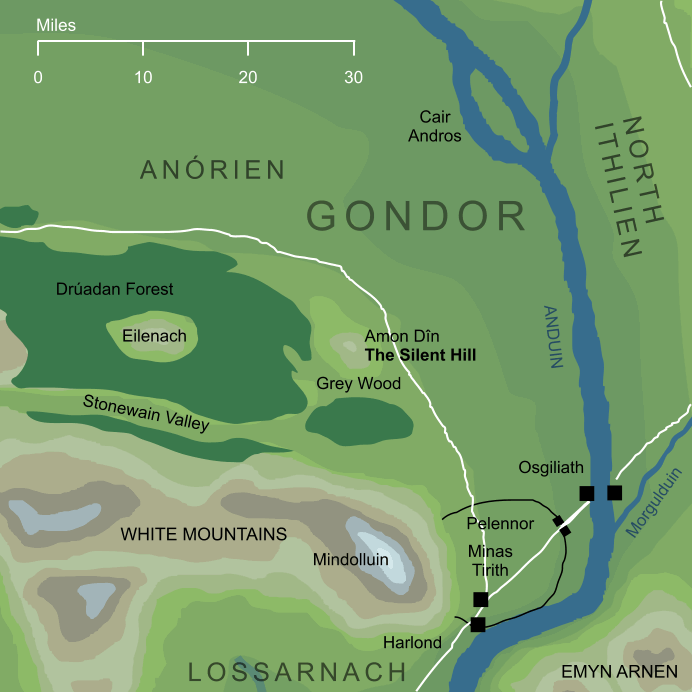The Encyclopedia of Arda - Silent Hill (original) (raw)

A prominent hill that rose from the wooded plains some twenty-five miles to the north of Minas Tirith. The lands around its feet were densely forested, with the wide Drúadan Forest stretching for miles to the west of the hill and the smaller Grey Wood lying at its southern feet. The hill itself was rocky and barren, showing few signs of trees or other life, and this perhaps was the source of its name: Amon Dîn, the Silent Hill.1
Early in the history of Gondor, its people chose the Silent Hill as a suitable place for a lookout post. Within sight of the city of Minas Anor (as Minas Tirith was then known) it commanded a view of the lands of Anórien, and from its summit enemies could be seen coming either from the wide lands to the northwest, or crossing Anduin at Cair Andros. The summit was fortified for this purpose (we have no details of this fortification, but presumably the soldiers garrisoned here occupied some kind of watchtower). In need of stone from the White Mountains for their great building projects, the early Gondorians cut a straight way through the mountains, running westward from the wooded feet of Amon Dîn, down which they carried stone from the mountain quarries far to the west.
In later times,2 a series of three beacons was set up to receive warning of trouble in Anórien. The Silent Hill of Amon Dîn was the first of these and closest to the City, and those on its summit watched for the lesser beacon on the narrow peak of Eilenach rising from Drúadan Forest to the west. This small system of beacons was extended later in history to encompass a total of seven mountains and hills, stretching across some two hundred miles from the Silent Hill as far the Halifirien on the borders of Rohan.
The Beacons of Gondor were lit in the year III 3019, as immense forces were arrayed against the city of Minas Tirith. The Rohirrim mustered their forces to answer the call, but a second army of Orcs had been deployed in Anórien to block their progress. With the aid of the Wild Men of Drúadan Forest, the Rohirrim were able to find the old long-forgotten Stonewain Valley, and continue their eastward ride. They emerged near the feet of the Silent Hill in time to join the Battle of the Pelennor Fields and turn the tide against the forces of Sauron.
Though the Riders of King Théoden helped to bring about victory in that battle, the King himself did not survive it. Later his body was returned to Edoras in a formal funeral procession, which followed the road that looped around the Silent Hill to the north. As they came to the feet of the hill, the procession stopped at the Grey Wood. There King Elessar made a pronouncement to the Drúedain of the woods, recognising the aid they had given, and granting them the Drúadan Forest as their own.
Notes
| 1 | Even Tolkien was unsure of the true source of the name, stating only that the reason the hill was known as 'silent' was unrecorded. He does present the idea that the name 'Silent Hill' came about because the rocky height was little visited by people or animals, but he couches this as speculation rather than established fact. |
|---|---|
| 2 | The exact dating of the first Beacons of Gondor is not known with certainty, but we do know that they became needed after the loss of the palantíri that had earlier been used for this function. This seems to have been in about III 2000, probably after the loss of Minas Ithil and its palantír in III 2002. |
Indexes:
About this entry:
- Updated 15 July 2023
- This entry is complete
For acknowledgements and references, see the Disclaimer & Bibliography page.
Original content © copyright Mark Fisher 1998, 2001, 2011, 2017, 2023. All rights reserved. For conditions of reuse, see the Site FAQ.